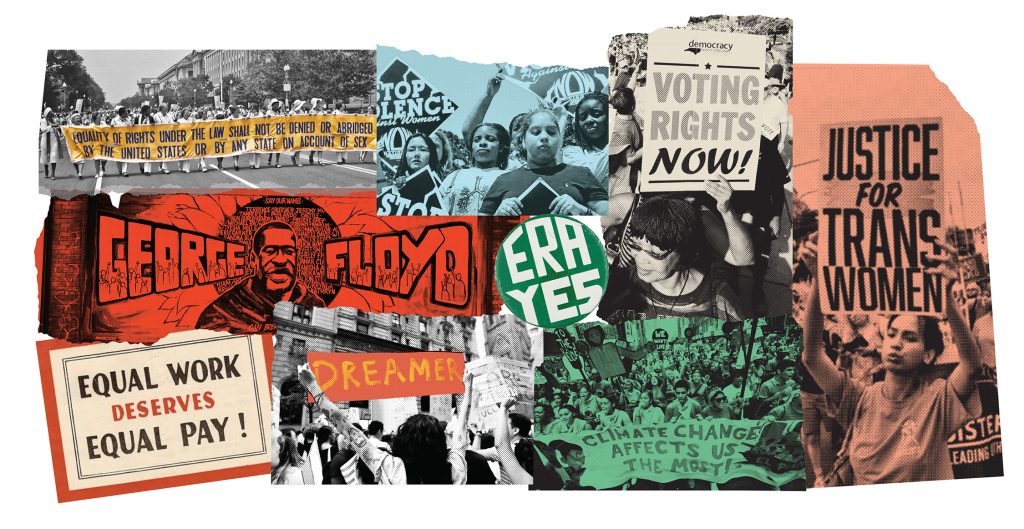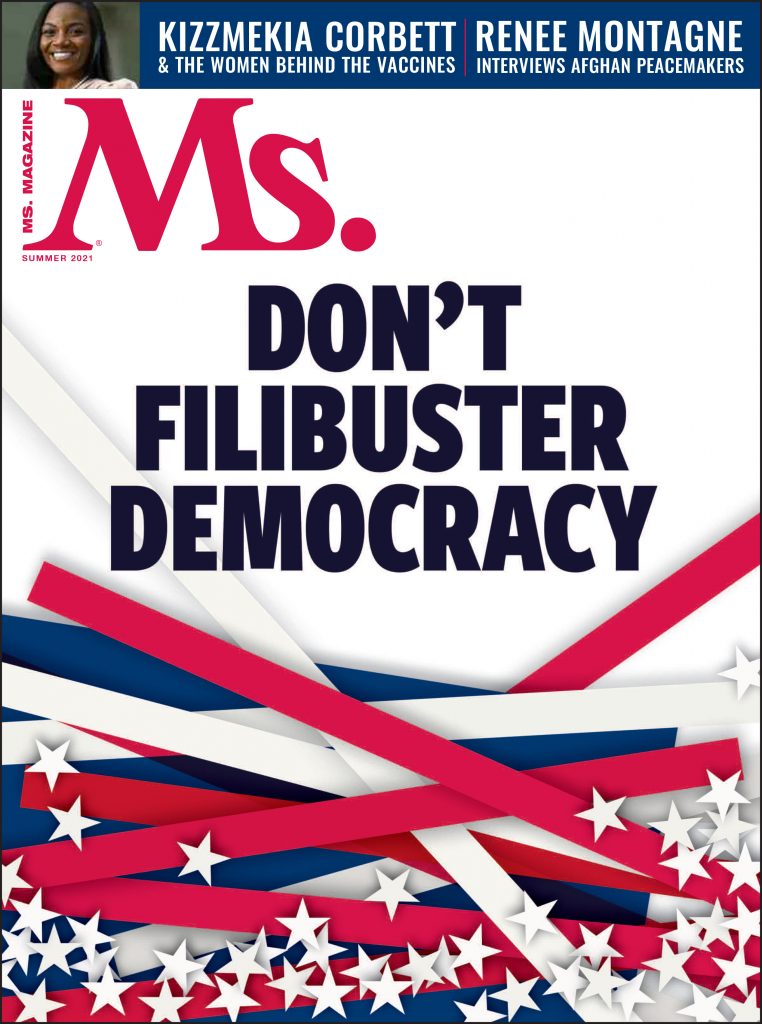The Equal Rights Amendment and other advancements for women’s and civil rights hinge on the battle to eliminate an antidemocratic Senate tactic.

At the funeral of Rep. John Lewis (D-Ga.) one year ago, former President Barack Obama paid homage to the late congressman’s legacy by calling for the realization of our nation’s unfulfilled promise of democracy for all. “And if all this takes eliminating the filibuster, another Jim Crow relic, in order to secure the God-given rights of every American,” Obama declared, “then that’s what we should do.”
Throughout the 20th century, the Senate regularly used the filibuster to undermine and thwart civil rights legislation—blocking measures such as anti-lynching bills, the Civil Rights Act of 1957 and proposals that would have prohibited poll taxes and discrimination in voting, housing and employment.
Procedural roadblocks have been similarly leveraged to derail critical gender equity advances of the modern era, most notably the Equal Rights Amendment. The ERA’s century-in-the-making path to ratification, now finally on the precipice of victory, faces its next immediate obstacle: the Senate filibuster.
Rules and Representation (or the Lack Thereof)
First, the basics. Derived from 19th-century Dutch and Spanish words for pirate—the direct translation is “freebooter”—the filibuster is a technical maneuver that, in theory, enables the Senate to slow down and deliberate. Rather than a simple majority of 51 votes to pass legislation (or confirm certain presidential appointees), 60 votes are required to move from debate to a full vote. But the filibuster’s use has morphed into full-blown abuse, a tool for obstruction and a means for grinding process—and progress—to a halt.
These days, the filibuster is routinely used to block even the most mundane matters from reaching the Senate floor. As for the big priorities? It has become nearly impossible for our elected leaders in Congress to advance the will of the people. An emblem of antidemocratic dysfunction, the filibuster has distorted the political process, deepened polarization, disrupted real-time lawmaking and governance—and deserted American ideals. Caroline Fredrickson, legal scholar and fellow at the Brennan Center for Justice at NYU Law (disclosure: I also work at the Brennan Center), further drives home the point in her October 2020 brief, “The Case Against the Filibuster,” writing, “The filibuster continues to undermine a real democracy.”
It also doubles down on minority rule in the Senate, a legislative body where Americans already do not enjoy equal or true representation. Consider California’s 39 million residents who have the same representation—two senators—as, say, Wyoming’s 579,000. According to The Washington Post, two-thirds of Americans will be represented by just 30 percent of the Senate by the year 2040.
As for the here and now, the Senate’s current composition—an even 50-50 partisan split—makes the breakdown feel that much more jarring. As historian Heather Cox Richardson explains in one of her “Letters from an American,”
“The 50 Democrats in the Senate represent over 41.5 million more people than the 50 Republicans represent. … Essentially, then, the fight over the filibuster is a fight not just about the ability of Democrats to get laws passed, but about whether [Senate Minority Leader Mitch] McConnell and the Republicans, who represent a minority of the American people, can kill legislation endorsed by lawmakers who represent quite a large majority.”
And on the topic of the Senate as a representative body: It is important to acknowledge persistent disparity when it comes to gender and race. Of the 100 senators now serving, only 11 are people of color. The United States now ranks 67th worldwide for women’s representation. Only 24 women currently serve in the Senate, three of whom are women of color and none of whom are Black; there have only ever been two Black women senators; and the most women to ever serve in the Senate at one time was 25.
Gridlock and Gamesmanship and the Fight for Gender Equity
What is at stake as we consider the immediate future of feminist priorities? The answer is just about everything: much-needed reform on voting rights, racial justice, education, economic dignity, gun safety, climate and immigration—among others. Many of these issues already have been taken up and passed by the House of Representatives, including major transformative bills needed to repair our systems of democracy and justice—the For the People Act and the George Floyd Justice in Policing Act among them.
There is also, at last, a real and vital opportunity to see the Equal Rights Amendment—the declaration that “Equality of rights under the law shall not be denied or abridged … on account of sex”—fully, finally recognized in the United States Constitution. With dedicated commitment from the White House and a diverse, multigenerational coalition from all corners of the country, 2021 could and should be the year the ERA crosses the finish line.
Launched into U.S. political life nearly a century ago (it was first introduced in Congress in 1923), the ERA has been no stranger to procedural ploys. By the time it passed in 1972, it had won a robust bipartisan vote with public support firmly on its side. But it was saddled with a preamble stating that the required ratification by three-quarters of the states had to be secured within seven years—an otherwise arbitrary timeline, one of the myriad diversions thrown in its path. In 1978, when the amendment was still three states short, activists won an extension to 1982, but the number of ratifying states remained stuck at 35.
States began stepping up in recent years in the wake of Donald Trump’s election and critical state legislative election victories by a record number of women and pro-equality men: First Nevada voted to ratify in 2017, then Illinois in 2018; in 2020, Virginia became the 38th state needed to meet the threshold to advance the amendment.
Notes Eleanor Smeal, a central leader of the ERA campaign over the decades and cofounder of the Feminist Majority Foundation (publisher of Ms.):
“Technical tricks and traps have been used to slow down the ERA for decades, from first getting it out of the House committee in 1970 to the inclusion of the time limit in the preamble by a notorious segregationist senator. We’ve seen it all along the way.”
In March, the House of Representatives passed a bipartisan resolution to remove the time limit for ERA ratification, the next key step in its path. Rep. Jackie Speier (D-Calif.), who introduced the resolution, spoke powerfully on the continued need for the ERA. “Since our country’s founding, women have been left out of the Constitution—intentionally. We were second-class citizens deprived of basic rights to vote, enter most jobs or own property. To this day, we are paid less for our work, violated with impunity and disproportionately suffer the burden of the COVID-19 pandemic,” she said on the House floor. “Enough is enough.”
Sens. Ben Cardin (D-Md.) and Lisa Murkowski (R-Alaska) introduced a companion bipartisan resolution in the Senate back in January. Which lands us where we are today, with Senate Republicans poised to … stall and stymie.
And yet, poll after poll shows the massive popularity of the ERA. It is what the public wants—so much so that nearly eight in 10 adults say they support adding the ERA to the Constitution, according to a Pew Research Center poll released in 2020, and most people wrongly assume there are already equal rights written into the Constitution! Even the conservative American Enterprise Institute called the ERA’s continued overwhelming support “impressive in a deeply polarized age.”

This article originally appears in the Summer 2021 issue of Ms. Become a member today to read more reporting like this in print and through our app.
“The opposition has always tried to convince us we don’t have the public on our side,” reflects Smeal. “But that is utterly not true now and has never been so. We must no longer entertain the notion that the reason [the ERA] hasn’t yet passed is our message. Rather, we must ask: Who is standing in the way? Because in reality, we just need to take the tools of power away from those who are trying to hold up progress.”
Inextricably connected with the ERA are several other critical policy priorities that are in motion in government and are at grave risk of Senate inaction or obstruction. Among these are three key bills that already have passed in the House.
The reauthorization of the Violence Against Women Act (VAWA) passed in the House on the very same day as the ERA. President Joe Biden often touts VAWA as a signature legislative accomplishment from his years as a senator. The current bill would make much-needed updates and enhancements to long-standing VAWA provisions, including strengthening enforcement of court orders that require convicted abusers to relinquish their firearms; closing the “boyfriend loophole” by prohibiting anyone convicted of dating violence from purchasing a firearm; extending protections to immigrant and transgender women; and ensuring Indigenous tribes’ jurisdiction over non-Native perpetrators of sexual assault and domestic violence on tribal lands.
The Paycheck Fairness Act was approved by the House in April. As Biden said in a public statement after its passage: “Equal pay is about justice, fairness and who we are as a nation.” The bill addresses the gender wage gap by closing loopholes that have enabled employers to justify pay disparities, demanding accountability for systemic pay discrimination and enabling workers to challenge pay disparities as a group.
The Equality Act, which passed in the House in February with support from the White House and businesses leaders nationwide, would extend the 1964 Civil Rights Act to cover sexual orientation and gender identity, including explicit anti-discrimination protections in workplaces, federally funded programs, housing, education and other public spaces. National intervention has become all the more urgent in the face of state legislatures introducing more anti-trans bills than ever before this year.
Opportunities to advance immigration reform risk being similarly squandered. Take, for example, the American Dream and Promise Act, passed by the House in March to establish a pathway to citizenship for Dreamers; the companion Farm Workforce Modernization Act also passed and would afford legal status for certain agricultural workers. Perhaps anticipating the intractability of the Senate, House members opted for piecemeal versions of Biden’s bolder vision. A more sweeping bicameral plan introduced by Sen. Robert Menendez (D-N.J.) and Rep. Linda Sánchez (D-Calif.)—the U.S. Citizenship Act of 2021—would offer a path to citizenship for most undocumented immigrants, make it easier for spouses and children to join their families here, and expand the number of work visas. But its chances of winning 60 votes in the Senate seem near impossible.
And then there is the Biden administration’s American Families Plan (AFP). It includes many long-sought feminist proposals for an inclusive economy—among these, expanded access to affordable child care, paid federal family and medical leave, financing for universal early education and free community college.
Critiques that Republicans have hurled at the AFP—Sen. Marsha Blackburn (R- Tenn.) responded by tweeting an article about day care in the Soviet Union—are a throwback to the very same scare tactics preceding the ERA’s initial passage. (When Congress passed a 1971 bill for nationally funded child care, it was vetoed by President Richard Nixon, who aligned it with communist sympathizers.) Biden rightly makes the case that we are falling behind the rest of the world as an economic and innovation catalyst. But the reforms included in the AFP are also surely a matter of justice and equality, as the coronavirus pandemic continues to shed light on America’s broken infrastructure and disparate distribution of caregiving.
The good news here: Even without filibuster reform or abolition, the AFP needs only to win majority support in the Senate (and approval by the Senate parliamentarian) since it falls within the criteria of legislation that reflects part of the budgeting process (otherwise known as reconciliation).
A diverse coalition of voices—from civil rights leaders to youth activists, and from academic experts to sweeping grassroots movements—recognize that the very future of our nation is at stake. And they are speaking up and out. As the Brennan Center’s Fredrickson says, “It all comes back to first principles of democracy. Whether we are talking about finally getting equality written into the Constitution or ensuring reproductive justice or enabling people to live free from gender-based violence, the first order of business is making sure those people’s voices are heard.”
We cannot afford to miss this urgent moment to advance the many crucial reforms already on the legislative floor, which will not be enacted under the status quo. Too many people’s lives and safety depend on the ability of Congress to rise to the occasion. Ending the filibuster is one of the essential requirements for advancing gender equity and justice for all.
Up next:





